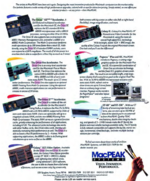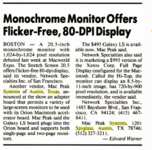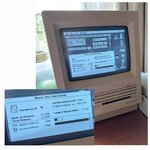CompactManiac
Well-known member
Back in late 80's MacPeak Systems were naming their accelerators and video adapters using some sort of futuristic 'star' theme with names like Orion and Galaxy. Did anyone ever own the Galaxy video board that plugs into the Orion accelerator in the SE and supported both single page and two page monitors?
I own the 16MHz Orion 68020 accelerator for an SE. I was aware there were faster versions available such as 20MHz and 25MHz.
Many SE accelerator boards had to sit on top of the original logic board and with the extra heat generated tended to warp.
I mention this because the connector slot on the Orion accelerator for plugging in the optional Galaxy video card would likely be very challenging to fit due to the warped board. I guess it would still be possible to attach the video board using extra wires going direct into the Orion slot but certainly not convenient or practical.
I bought the Orion board in 1991 second hand because I needed an 020 processor to run specific software and couldn't afford a Macintosh II.
I recall noticing the video port and also reading a very brief mention about it in the Orion installation Guide.
I contacted MacLine where I had bought it to try to find out more but they could not provide me with any further information.
They were unable to confirm if the board even existed which seemed mysterious!
Now some 33 years later (better late than never) I did some investigative work and try to find out if this mythical video adapter really did exist or not.
Searching the OCR version of US MacUser I found the December 1988 edition had the following full page colour ad:

Notice the Galaxy ECL Video Option.
Also searching online I found that circa August 1987 it was apparently available from MacPeak Systems for $495.

Did anyone ever own this infamous video card?
I'm sure it fitted originally before the accelerator board warped with so much heat but it would have been a nightmare trying to keep it fitted or ever refitting it.
Maybe that's why there was virtually no mention in the installation guide and dealers were not referencing it anymore.
It was very hot inside the SE with literally two full logic boards connected without adding a third so this might have been one too many innovations!
I own the 16MHz Orion 68020 accelerator for an SE. I was aware there were faster versions available such as 20MHz and 25MHz.
Many SE accelerator boards had to sit on top of the original logic board and with the extra heat generated tended to warp.
I mention this because the connector slot on the Orion accelerator for plugging in the optional Galaxy video card would likely be very challenging to fit due to the warped board. I guess it would still be possible to attach the video board using extra wires going direct into the Orion slot but certainly not convenient or practical.
I bought the Orion board in 1991 second hand because I needed an 020 processor to run specific software and couldn't afford a Macintosh II.
I recall noticing the video port and also reading a very brief mention about it in the Orion installation Guide.
I contacted MacLine where I had bought it to try to find out more but they could not provide me with any further information.
They were unable to confirm if the board even existed which seemed mysterious!
Now some 33 years later (better late than never) I did some investigative work and try to find out if this mythical video adapter really did exist or not.
Searching the OCR version of US MacUser I found the December 1988 edition had the following full page colour ad:

Notice the Galaxy ECL Video Option.
Also searching online I found that circa August 1987 it was apparently available from MacPeak Systems for $495.

Did anyone ever own this infamous video card?
I'm sure it fitted originally before the accelerator board warped with so much heat but it would have been a nightmare trying to keep it fitted or ever refitting it.
Maybe that's why there was virtually no mention in the installation guide and dealers were not referencing it anymore.
It was very hot inside the SE with literally two full logic boards connected without adding a third so this might have been one too many innovations!
Last edited:



